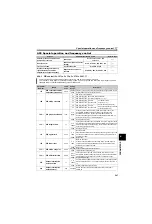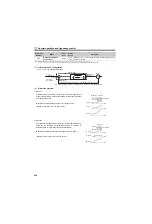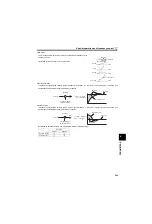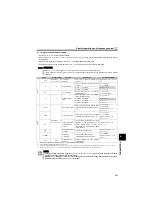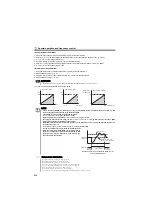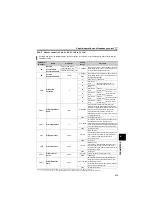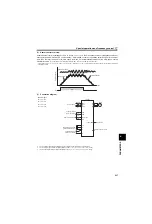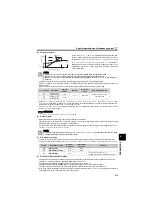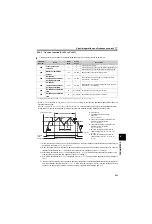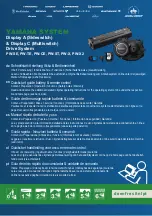
213
Special operation and frequency control
(8) Adjustment procedure
(9) Calibration example
(A detector of 4mA at 0
°
C and 20mA at 50
°
C is used to adjust the room temperature to 25
°
C under PID control.
The set point is given to across inverter terminals 2-5 (0 to 5V).)
Parameter setting
Adjust the PID control parameters,
Pr. 127
to
Pr. 134
.
Terminal setting
Set the I/O terminals for PID control (
Pr. 178
to
Pr. 182 (input terminal
function selection), Pr. 190
,
Pr. 192 (output terminal function selection)
)
Turn on the X14 signal.
When X14 signal is not assigned, setting a value other than "0" in
Pr.
128
activates PID operation.
Operation
Detector specifications
When 0 4mA and 50 20mA are used, the set point 25 is 50% on
the assumption that 4mA is 0% and 20mA is 100%.
Set the room temperature to 25 C.
Set
Pr. 128
and turn on the X14 signal to enable PID control.
Start
Determination of set point
Conversion of set point into %
Make calibration.
Setting of set point
Operation
Is the set point stable?
Parameter adjustment
Parameter optimization
Adjustment end
Yes
No
When the parameter unit is used for operation, input the set point (0 to
100%) in
Pr. 133
.
When performing operation, first set the proportional band (
Pr. 129
) to a
slightly larger value, the integral time (
Pr. 130
) to a slightly longer time,
and the differential time (
Pr. 134
) to "9999" (no function), and while looking
at the system operation, decrease the proportional band (
Pr. 129
) and
increase the integral time (
Pr. 130
).
Determine the set point of
what is desired to be adjusted.
Calculate the ratio of the set
point to the detector output.
Input a voltage across terminals
2-5 according to the set value %.
To stabilize the measured value,
change the proportional band (
Pr.
129
) to a larger value, the integral
time (
Pr. 130
) to a slightly longer
time, and the differential time (
Pr.
134
) to a slightly shorter time.
While the measured value is stable
throughout the operation status, the
proportional band (
Pr. 129
) may be
decreased, the integral time (
Pr. 130
)
decreased, and the differential time
(
Pr. 134
) increased.
Set the proportional band (
Pr.
129
) to a slightly larger value,
the integral time (
Pr. 130
) to a
slightly longer time, and the
differential time (
Pr. 134
) to
"9999" (no function), and turn
on the start signal.
Make the following calibration* when the target setting input (0 to 5V) and
detector output (4 to 20mA) must be calibrated.
When the set point is 50%
As the terminal 2 specifications are 0% 0V and 100% 5V, input 2.5V
to the terminal 2 for the set point of 50%.
When calibration
is required
Using calibration
Pr. 902
and
Pr. 903
(terminal 2) or
Pr. 904
and
Pr. 905
(terminal
4), calibrate the detector output and target setting input.
Make calibration in the PU mode during an inverter stop.
*
Содержание FR-D700 Series
Страница 11: ...VII MEMO ...
Страница 23: ...12 MEMO ...
Страница 57: ...46 MEMO ...
Страница 262: ...258 MEMO ...
Страница 276: ...272 MEMO ...
Страница 283: ...279 APPENDIX This chapter provides the APPENDIX of this product Always read the instructions before using the equipment ...
Страница 287: ...283 MEMO ...
Страница 289: ......









